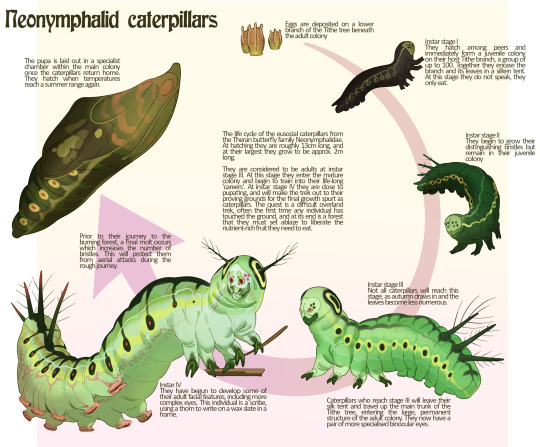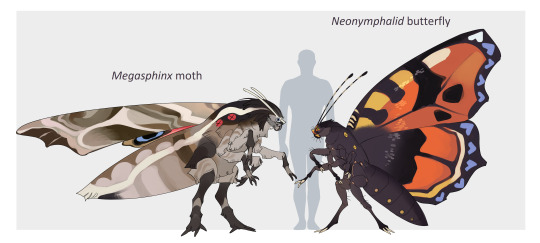#lov me bugs. insects are always fighting 1000 wars and battles and losing most of the time
Text


bugs big ones from Thera! the transcript for the top image is under the cut below.
There is a big lie in this which is that the caterpillar pictured in the top image is in fact Nettlerove who is a beetle of the species Cryptostenus oculatus. But he is a brood parasite of these caterpillars, and appears almost identical to one prior to pupation. They emerge as imagos earlier than the true butterflies around them, and then eat their defenceless colonymates. Life's rough for insects. i really wanted to draw baby (and young adult) Nettlerove sooo much so that's why it's him.
The Tithe tree is one of the reasons our bugs are so big. These trees are gigantic and their leaves are incredibly nutrient rich, and their huge hollow trunks are perfect for building colonies in. The social behaviour of these caterpillars is based off of Eriogaster lanestris, a moth which has eusocial silk-tent-spinning caterpillars :) Their true 'child' stage (instars 1 and 2) lasts a single spring and summer, while the subsequent instar stages last several years each. At pupation the individual can be up to 14 years old. The kids are basically left in their tent entirely unsupervised, and in fact it's an intentional strategy to have them on a lower branch than the main colony; any terrestrial predator looking for food will hopefully eat the kids first and leave the main colony alone (Life's ROUGH for insects!!).
Because the caterpillars are considered adults post instar 3, the winged form is not called "the adult" it's just the imago.
[Transcript: Neonymphalid Caterpillars
The life cycle of the eusocial caterpillars from the Theran butterfly family Neonymphalidae. At hatching they are roughly 13cm long, and at their largest they grow to be approx. 2m long.
They are considered to be adults at instar stage III. At this stage they enter the mature colony and begin to train into their life-long 'careers'. At instar stage IV they are close to pupating, and will make the trek out to their proving grounds for the final growth spurt as caterpillars. The quest is a difficult overland trek, often the first time any individual has touched the ground, and at its end is a forest that they must set ablaze to liberate the nutrient-rich fruit they need to eat.
Eggs are deposited on a lower branch of the Tithe tree beneath the adult colony
Instar stage I: They hatch among peers and immediately form a juvenile colony on their host Tithe branch, a group of up to 100. Together they encase the branch and its leaves in a silken tent. At this stage they do not speak, they only eat.
Instar stage II: They begin to grow their distinguishing bristles but remain in their juvenile colony
Instar stage III: Not all caterpillars will reach this stage, as autumn draws in and the leaves become less numerous. Caterpillars who reach stage III will leave their silk tent and travel up the main trunk of the Tithe tree, entering the large, permanent structure of the adult colony. They now have a pair of more specialised binocular eyes.
Instar IV: They have begun to develop some of their adult facial features, including more complex eyes. This individual is a scribe, using a thorn to write on a wax slate in a frame.
Prior to their journey to the burning forest, a final molt occurs which increases the number of bristles. This will protect them from aerial attacks during the rough journey.
The pupa is laid out in a specialist chamber within the main colony once the caterpillars return home. They hatch when temperatures reach a summer range again.]
#btw if you've never actually looked at caterpillar prolegs. well they look like that close up#setting: thera#lov me bugs. insects are always fighting 1000 wars and battles and losing most of the time#speculative biology#speculative evolution
203 notes
·
View notes